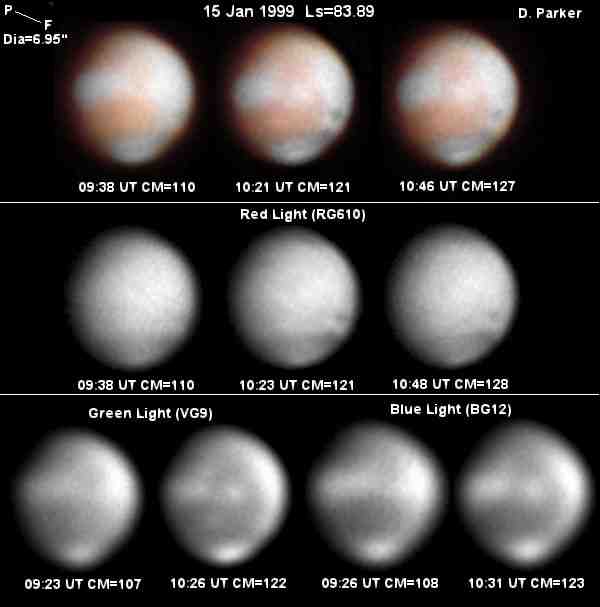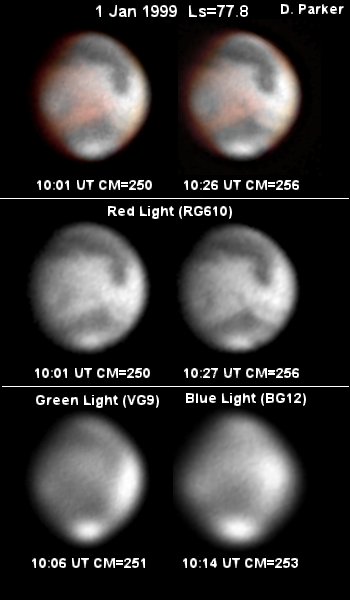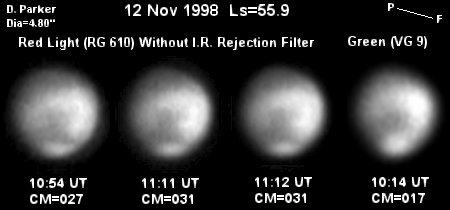
We here treat the observations made during the period
The following are the observers and observations that contributed to the CMO this time:
AKUTSU, Tomio (Ak) Karasuyama, Tochigi, Japan
7 CCD Images (26 November; 26, 29 December 1998; 3, 13 January 1999)
f/? 32cm speculum, Lynxx PC
GRAY, David (DGr) Durham, UK
2 Drawings (7, 10 January 1999) 415, 660× 42cm Dall-Kirkham
HIGA, Yasunobu (Hg) Naha, Japan
1 CCD Image (17 December 1998) 25cm spec, Sony DCR-TRV900 / Photoshop
HIKI, Toshiaki (Hk) Minowa, Nagano, Japan
22 Drawings (17,18,20-24,26,27,30,31 December 1998;
1,4,7,8,12,14 January 1999)
340, 360× 16cm speculum
ISHADOH, Hiroshi (Id) Naha, Japan
6 Drawings (24, 29, 30 December 1998; 2 January 1999)
530× 31cm speculum
MELILLO, Frank J (FMl) N‚x, USA
3 CCD Images (27 December 1998; 2 January 1999)
20cm SC Starlight Xpress MX-5
MINAMI, Masatsugu (Mn) Fukui, Japan
61 Drawings (17, 18, 21, 25-28 December 1998; 4, 5 January 1999)
400, (600), (630)× 20cm refractor*
MURAKAMI, Masami (Mk) Yokohama, Japan
25 Drawings (20#, 22#, 27# December 1998; 1,3,4,5,8,13,15 January 1999)
(#) 370× 15cm speculum / 320× 20cm Saheki speculum
NAKAJIMA, Takashi (Nj) Fukui, Japan
35 Drawings (17, 18, 21, 25, 27, 28 December 1998; 4, 5 January 1999)
400× 20cm refr*
NARITA, Hiroshi (Nr) Kawasaki, Japan
8 Drawings (5-8, 10-13 January 1999) 400× 20cm refractor
PARKER, Donald C (DPk) FL, USA
15 CCD Images($) (27, 31 October; 12, 19 November;
19, 23, 25 December 1998; 1, 9, 15 January 1999)
f/55 41cm speculum equipped with Lynxx PC
WHITBY, Samuel R (SWh) VA, USA
1 Drawing (6 January 1999) 310× 15cm speculum
* Fukui City Observatory
($) Note please the total number of the CCD images sent from Don PARKER is many more, more than 4 times 15 because each colour image is accompanied by the three decomposed images and also supplemented by those taken within 40 minutes.
We have at least three particular points to be emphasised from our view side; 1) the bright evening Chryse, 2) a large reddish area following M Acidalium and 3) a fading of the Utopia region, but we here trace the surface in featuring some typical markings sequentially.

Olympus Mons:
It was at 076°Ls in 1997 that we observed Olympus Mons covered by cloud to be like a cotton-ball floating (cf #185, 188; and also Fig 8 in #201 at p2247) and hence Mn intensively watched the area on 18 Dec at 072°Ls when ω=152°W, 161°W and so on, but in vain. The seeing condition is another problem, but the obscurity must have been due to the fact that the disk area was only 1/4 of the previous case since in 1997 the apparent diameter was 11.5" (while this time it was 5.7"). On 7 Jan at 080°Ls David GRAY (DGr) caught a light Olympus Mons at ω=122°W when the app. diam. =6.5". Not particularly bright, but its northern shadowy border was clear. Since the phase angle=36°, the local Martian time of Olympus Mons was about 1:20pm: We should say we need the image two or three hrs later. On 15 Jan at 085°Ls Don PARKER (DPk) separated a light roundish Olympus Mons from the Tharsis white area in G and B. The angle and the phase angle was the same as DGr's: ω=122°W (phase angle ι =36°).
Elysium:
HIGA (Hg)'s colour image on 17 Dec (071°Ls) at ω=193°W shows the area of Elysium is indefinitely whitish, while the area was dim to our eyes this period. On 6 Jan at 080°Ls, Sam WHITBY (SWh) discerned a bright Elysium near the morning limb at ω=132°W. On 9 Jan at 081°Ls, DPk nicely caught the whitish morning Elysium at ω=162°W & 172°W: The R image at ω=178°W shows well the classical boundary. The latter image is excellent and shows Olympia detached from the npc. The whitish evening Elysium is seen on DPk's image on 1 Jan (078°Ls) at ω=250°W.
Propontis I:
The area including Propontis I was quite dark, and it was about to be separated on 21 Dec at ω=171°W, but the app. diam.=5.9". ISHADOH (Id) also had a similar awareness on 24 Dec at ω=141°W. Propontis I is there, and DPk's image in R taken as early as on 27 Oct when app. diam.=4.5". This is not only a problem of resolution power, but the naked eyes are inferior in momentary reaction. On 15 Jan (084°Ls) at ω=122°W, DPk detected an early morning Propontis I: its northern Cebrenia being atmospherically disturbed.
Chryse-Xanthe:
On 19 Dec (072°Ls, App.diam. δ=5.8") at ω=011°W, the morning Chryse-Xanthe on DPk's image is whitish bright. A nice image by DPk on 23 Dec (074°Ls) at ω=346°W, Chryse very whitish bright in the morning. Niliacus L is separated from M Acidalium due to a morning haze. On our side on 4 & 5 Jan at 079°Ls we saw the morning white Chryse. Remarked here in Japan was the conspicuous appearance of the evening hazed Chryse-Xanthe. For example, Mn watched the area to be clear but though not-glossy on 26 Dec (075°Ls) from 17:10GMT (at ω=053°W) to 21:50GMT (at ω=121°W). At ω=053°W it was as bright as the npc. Same on 27 Dec. Id observed it and clearly depicted on his drawings on 29 Dec (076°Ls) at ω=088°W, 2 Jan (078°Ls) at ω=054°W and so on.
Tempe from M Acidalium:
Mn observed on 27 Dec (076°Ls) & on 28 Dec (at ω=063°W and so on) that when M Acidalium was going to sink to the evening terminator its following area, including Tempe, looked rather largely shadowy. This must have shown that we were faced with the so-called densely reddish region (to be explained in another column) without white haze. HIKI (Hk) noticed this fact also on 27 Dec at ω=097°W and so on. On the other hand, DGr observed on 10 Jan (082°Ls) at ω=113°W that the region was rather misty, and in particular a part of the dark region near the CM surrounding the npc was faded. The morning Tempe was whitish misty. DPk's image on 19 Dec (072°Ls) at ω=011°W shows M Acidalium to be a proper dark area but its following area is thickly white. This image, as above-cited, is excellent to the extent that Hyperboreus L and Iaxartes are visible.

Solis L:
We first saw Solis L on 26 & 27 Jan (for example on 27 Dec at ω=077°W by Nj and on 28 Dec at ω=072°W by Mn). Hk also saw it on 27 Dec at ω=086°W.
Syrtis Mj, Hellas and Utopia:
DPk obtained an excellent image on 1 Jan (078°Ls) at ω=250°W in which N Alcyonius is shown. Aeria light. Hellas is not so bright (in B). The area faced to Japan a fortnight later, and the area was seen from 13 Jan. On 15 Jan (084°Ls) at ω=280°W and so on, MURAKAMI (Mk) detected Utopia to be less dark than Syrtis Mj; the fact being different to the preceding turn. Hellas dull, but its evening part lighter. AKUTSU (Ak) secured the CCD images on 13 Jan at ω=290°W: Syrtis Mj and Utopia clearly visible and a bit Hellas in R. The B image is not good yet.
The ebm:
DPk's B images on 25 Dec (075°Ls) at ω=310°W & 318°W show a clear stream of thin mist along the Equatorial Band. Mn felt on 28 Dec (086°Ls) at ω=072°W a disk-wide stream to the north of Solis L to the evening Chryse. Similarly an EB Mist on 4 Jan (079°Ls) at ω=000°W.
The north polar cap: The npc has been clear. The size looked normal though not yet measured. Frank MELILLO (cf LtE) discusses a possible irregularity, but the unstable R images may not be appropriate to say something. Hg's colour image on 17 Dec (971°Ls) at ω=193°W shows that the npc is completely inside the disk. As suggested above, DPk's CCD on 9 Jan (081°Ls) at ω=178°W shows Olympia. Already, the npc taken on 25 Dec (075°Ls) at ω=310°W shows a complexed right and shade inside it depending on the result from R image.
We-Further-Received: from Ak an earlier one on 26 Nov at ω=037°W in which M Acidalium is clearly shown in R.

The first image by DPk, as far as we received, was an R image taken on 27 Oct (049°Ls) when
App. diam. δ=4.5" at ω=185°W where Propontis I is evident and the existence of Elysium. Cebrenia broader. On 31 Oct (051°Ls) at ω=150°W‚ĹPropontis dark and Phlegra evident. Elysium is not particularly light. On 12 Nov (056°Ls) at ω=031°W, M Acidalium is near the CM where IR images and non-used ones of the IR filter are compared. On 19 Nov (059°Ls) at ω=315°W, a total of S Sabaeus is clearly visible. In B, the white area at the npr is so larger that the composed image show as it were a np hood invading up to the Ismenius-L area.